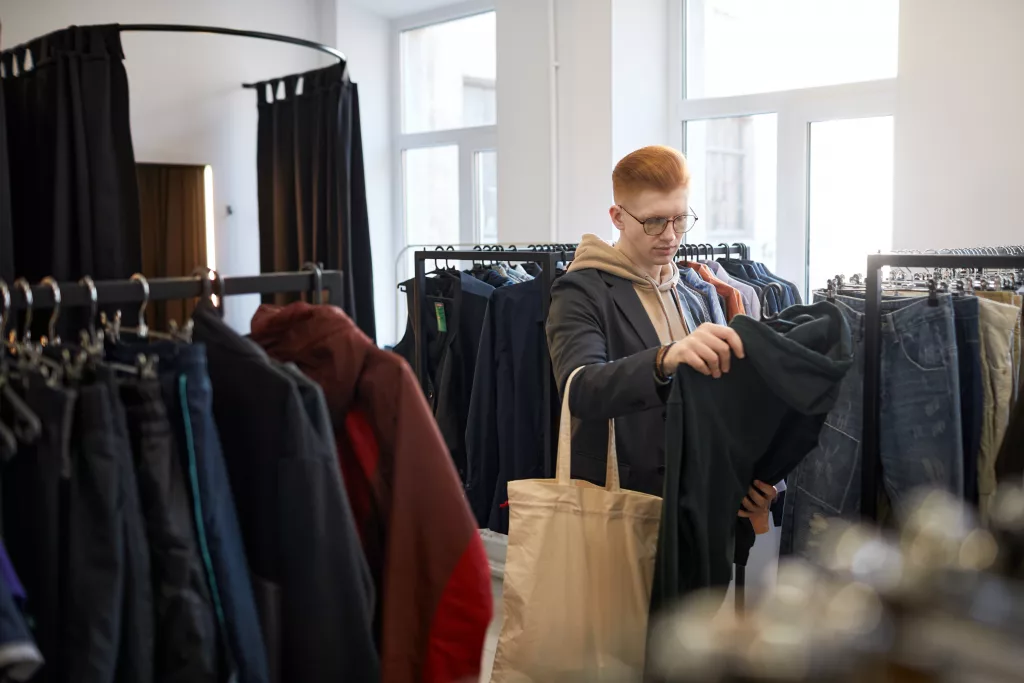Thrifting is more than just a trend; it’s a lifestyle that combines the thrill of the hunt with the benefits of sustainability and savings.
Whether you’re new to the world of second-hand shopping or looking to sharpen your skills, here are some essential tips to help you make the most of your thrifting adventures.


What is Thrifting and Why is it Popular?
Thrifting involves shopping for second-hand items at thrift stores, garage sales, flea markets, or online platforms like eBay and Depop. It’s gaining popularity for several reasons. Firstly, thrifting is a cost-effective way to acquire quality goods without breaking the bank.
Additionally, buying second-hand promotes sustainability by reducing waste and the demand for new production. Thrift stores are treasure troves of unique, one-of-a-kind items that you won’t find in mainstream retail stores, appealing to those seeking individuality.
Many people are drawn to the charm and nostalgia of vintage items, appreciating the craftsmanship and style of earlier eras. Moreover, thrifting allows consumers to avoid supporting industries associated with fast fashion and unethical labour practices, making it an ethical choice for conscious shoppers.
Benefits of Shopping Second-Hand
Thrifting offers numerous advantages that make it an appealing choice for many. The cost savings are significant compared to buying new items, allowing you to stretch your budget further and potentially afford higher-quality pieces.
Shopping second-hand extends the lifespan of products and reduces your environmental footprint by conserving resources and lowering waste. Thrift stores often yield unique finds, from vintage clothing to rare collectibles, adding character and history to your possessions.
Many older items are well-made and durable, offering longevity that newer, mass-produced items may lack. Furthermore, many thrift stores support charitable causes or local businesses, allowing your purchases to contribute to positive community initiatives.
Thrifting for a Sustainable Lifestyle
Incorporating thrifting into your lifestyle promotes sustainability in various ways. By purchasing second-hand items, you keep them out of landfills and reduce waste. Thrifting lowers the demand for new production, conserving natural resources and reducing pollution associated with manufacturing. It also encourages the reuse and repair of items, extending their lifespan and contributing to a circular economy.
Buying second-hand typically involves less packaging, reducing waste from plastic and other materials. Moreover, thrifting helps reduce support for the fast fashion industry, known for its environmental and ethical issues, and fosters a greater appreciation for the items we own, promoting mindful consumption.
Spotting High-Quality Items
To find high-quality items while thrifting, you need a discerning eye. Look for natural fibres like cotton, wool, silk, and linen in clothing, as they are generally more durable and breathable than synthetic fabrics. For furniture, seek out solid wood, genuine leather, or metal components, which tend to be sturdier and longer-lasting. Examine the construction of items, check for straight stitching, reinforced seams, and quality finishes in clothing, and ensure furniture is sturdy with tight joints.
Familiarize yourself with brands known for quality craftsmanship, and check for sturdy and functional hardware in clothing, such as buttons and zippers. Pay attention to the condition of items, looking for well-maintained pieces with minimal signs of use. Finally, ensure clothing fits well and is comfortable, as even well-made items are less likely to be worn if they don’t fit properly.
Red Flags to Watch Out For
Be cautious of certain red flags when evaluating second-hand items. Excessive signs of wear, such as holes, stains, and fading, may indicate heavy use. Check for visible damage or repairs, as extensive damage can be costly to fix. Be wary of items with strong odours like mustiness, smoke, or pet smells, as these can be difficult to remove. Poor construction, such as uneven stitching and loose seams, signals low quality. Ensure all components are present and functional, and be cautious of items priced significantly below their market value, as they may be counterfeit or defective. Verify sizes when shopping for clothing, as labels can be inaccurate.
Cleaning and Sanitizing Thrifted Items
To ensure your thrifted items are clean and safe to use, follow proper cleaning and sanitizing methods. Most clothing can be machine-washed using regular laundry detergent, while delicate fabrics may require dry cleaning.
For furniture, vacuum and spot clean upholstery, and use a steam cleaner for deep cleaning.
Hard surfaces should be wiped down with a mild detergent and disinfectant.
Washable toys can be cleaned in the dishwasher or washing machine, while non-washable toys should be wiped down with disinfectant cleaner or sanitizing wipes.
For electronics, use a soft cloth or electronics-safe wipes, and sanitize with a mixture of isopropyl alcohol and water.
Upcycling and Repurposing
Get creative with your thrifted finds to fit your style. Clothing and accessories can be altered, embellished, or refashioned into unique pieces. For furniture and home decor, consider painting, refinishing, or reupholstering items to give them a new look.
Repurpose items for new uses, such as turning an old dresser into a kitchen island or vintage suitcases into storage containers. Use thrifted materials for DIY projects, like creating custom home accessories or art pieces. Combine thrifted items with existing decor elements to create eclectic and personalized arrangements, and add personal touches like monograms or stencilling to make items uniquely yours.
Final Tips for Thrifting
Inspect items thoroughly for signs of wear, damage, and authenticity. Consider the potential of items and how you can upcycle or repurpose them to suit your needs. Be patient and persistent, as great finds often require time and effort. Regular visits to thrift stores can increase your chances of discovering hidden gems.
Embrace thrifting not just as a way to save money, but as a means to promote sustainability, find unique treasures, and make more ethical purchasing decisions. Happy thrifting!
At Bank & Vogue, we have innovative solutions for the crisis of “stuff”. To learn more about how we are helping empower a sustainable world, click here.








